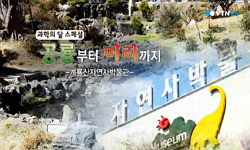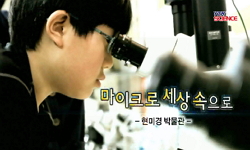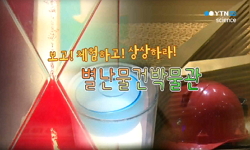정보매체의 발달로 빠르게 변화하는 사회 속에서 사람들의 의식수준이 높아지면서 박물관을 향한 요구는 더욱 다양화 되고 있다. 관람객들의 다양한 요구에 따라 박물관·미술관의 운영비�...
http://chineseinput.net/에서 pinyin(병음)방식으로 중국어를 변환할 수 있습니다.
변환된 중국어를 복사하여 사용하시면 됩니다.
- 中文 을 입력하시려면 zhongwen을 입력하시고 space를누르시면됩니다.
- 北京 을 입력하시려면 beijing을 입력하시고 space를 누르시면 됩니다.
박물관 뮤지엄샵 문화상품개발 및 활성화 방안 = A Study on the Development of Cultural Commodities at Museum Shop as A Way of Rehabilitation of Museum
한글로보기https://www.riss.kr/link?id=T11596586
- 저자
-
발행사항
서울 : 명지대학교 문화예술대학원, 2009
-
학위논문사항
학위논문(석사) -- 명지대학교 문화예술대학원 , 박물관학과 , 2009. 2
-
발행연도
2009
-
작성언어
한국어
- 주제어
-
DDC
069 판사항(22)
-
발행국(도시)
서울
-
형태사항
Ⅶ, 146 p. ; 26cm
-
일반주기명
명지대학교 논문은 저작권에 의해 보호받습니다.
지도교수:전태일
참고문헌 : p.140-143 - 소장기관
-
0
상세조회 -
0
다운로드
부가정보
국문 초록 (Abstract)
정보매체의 발달로 빠르게 변화하는 사회 속에서 사람들의 의식수준이 높아지면서 박물관을 향한 요구는 더욱 다양화 되고 있다. 관람객들의 다양한 요구에 따라 박물관·미술관의 운영비는 더욱 증가하게 되는데, 운영재정은 오히려 감소하기 때문에 심각한 운영난을 겪게 된다. 운영재정이 열악한 상태에서 문화기관의 역할과 기능을 제대로 감당할 수 없기에 지역의 문화발전 및 문화선진국으로 나아가는데 저해요인이 될 수 있다. 그러므로 열악한 운영재정에 도움을 줄 수 있고, 박물관·미술관 활성화를 이끌어 낼 수 있는 수익사업개발 및 발전을 위한 연구가 이루어져야한다. 국외 선진국들의 박물관·미술관 운영사례를 분석해 보면 다양한 수익사업을 개발, 운영함으로써 재정증대 및 활성화에 도움을 얻고 있음을 알 수 있다. 그 중에서 가장 적극적이고, 활발하게 운영되고 있는 것이 뮤지엄샵 문화상품개발 및 판매이다. 문화상품은 전시유물과 연계 되고, 박물관·미술관 고유 이미지를 담고 있기 때문에 시중의 상품이나 기념품과는 구별되며 뮤지엄샵에서의 문화상품 판매는 재정증대뿐만이 아니라 박물관·미술관의 발전에 기여하게 된다.
국내박물관·미술관들은 비영리 기관이라는 특성 때문에 입장료 외에 다른 수익사업에 대하여 적극적이지 못했다. 이제 국내박물관·미술관들도 다양한 수익사업을 전개함으로써 운영재정 및 질 높은 문화 기관으로써의 역할 감당을 위해 노력해야한다. 또한, 국내·외 뮤지엄샵 운영사례 및 상품개발현황을 분석하여 각 박물관·미술관의 현실에 맞는 문화상품 개발 및 판매을 위해 좀 더 적극적으로 임해야 할 것이다.
각 박물관·미술관들이 수익사업을 운영하는 가장 중요한 목적은 부족한 운영재정의 확보에 있다. 그렇기 때문에 관람객들이 가장 선호하고, 매출증대를 이끌어 낼 수 있는 상품개발에 주력해야 한다. 문화상품의 기능과 역할은 다양하기 때문에 문화상품 매출증대는 곧 박물관·미술관 발전을 도모하게 되고 활성화를 이끌어 내게 될 것이다. 관람객 재방문 유도, 박물관 브랜드이미지를 통한 홍보, 교육적 기능 및 문화의 보급, 전시연장으로써의 역할과 기능 등, 박물관·미술관 발전에 중요한 역할을 감당한다. 관람객들은 이제 더 이상 수동적이지 않다. 박물관·미술관을 방문했을 때 전시물을 감상하는 것만으로 만족하지 않는다. 지식의 증대 및 문화의 향유와 더불어 더 많은 볼거리, 즐길 거리를 요구한다. 그렇기 때문에 관람객을 만족시킬 수 있고 재정증대를 통한 박물관·미술관 활성화를 도모할 수 있는 문화상품개발이 중요한 연구과제이다.
결론적으로 뮤지엄샵 문화상품은 박물관·미술관 고유 이미지를 담고 있으며, 박물관고유의 정체성이 체화되어있을 때 이런 역할을 감당 할 수 있다. 그러기 위해서는 문화상품이 직접 개발되어 기성의 상품과는 다른 독창적이고 창의적인 상품이 만들어져야 한다. 그러나 국내의 현실에서 문화상품을 직접 개발하고 제작한다는 것은 오히려 박물관·미술관 운영 재정에 더 큰 어려움을 가져 올 수 있기 때문에 문화상품개발의 중요성을 인식하면서도 기피하게 된다. 국내의 문화상품과 관련된 여러 문제점이 해결된다면 박물관·미술관들이 문화상품개발에 주력하게 될 것이고 이것은 곧 국내 뮤지엄샵 문화상품 발전에 원동력이 될 것이다.
문화상품은 수익창출만을 목적으로 하는 것이 아니라 다양한 기능과 역할을 통한 국내박물관·미술관발전에 기여하기 때문에 문화선진국으로 한 걸음 다가서기 위해서는 기관이나 정부 모두 문화상품 개발을 기피하는 국내의 현실을 직시하고, 문제해결을 위해 노력해야 할 것이다.
다국어 초록 (Multilingual Abstract)
In rapidly changing society along with the advancement of informational media, people's culturalc on sciousness is elevated and their expectationsfrom museum becomediversified.Themanagementexpenses in museumsand artmuseumsincreaseto meetvariousdemands...
In rapidly changing society along with the advancement of informational media, people's culturalc on sciousness is elevated and their expectationsfrom museum becomediversified.Themanagementexpenses in museumsand artmuseumsincreaseto meetvariousdemandsofthe audiences,whereastheallocated financesarecontinuously curtailed;whatresults is serious difficulties in museum maintenance. Poor financialconditionsmakeithardformuseumstoundertaketheroleandfunctionasaculturalinstitution,which,inturn,posesanobstacleforustorealizea culturallyadvancedcountry.Seriousstudiesarerequiredtofindsourceofrevenueformuseumsinordertorehabilitatetheirrolesandfunctions.Itisnotablethatforeign museumshavepreparedlong-term revenueproducing enterprisesto augmentmanagementfinances.Oneofthemostprevalent and prolific enterprises with such purpose is the sale of cultural commodities in museum shop.Culturalcommodity is distinguished from ordinary goods and souvenirs in thatithas directconnection with the materialsonexhibitionandrepresentthedistinctiveimageofthemuseum where it is sold.In this regard,the sale of culturalcommodities at museum shop contributes not only to themuseum's financial stability but also to its publicityas well.
Domesticmuseumsand artmuseumshavenotbeen allowed tolaunch revenue producing activities because oftheirlegalstatus as a nonprofitinstitution. However, it is time to permit the museums to conduct profit-making enterprises to augmentfinances and improve theirservice qualities. The foreign as well as domestic instances of museum management and the development of cultural commodities are to be examined to prepare strategies forthe developmentand sale ofcultural commodities that fit with the practical circumstances in which an individualmuseum issituated.
Theprimary reason ofprofit-making activitiesconducted by museums and art museums is to find sufficientfunds for management.So the effortsshouldbefocusedonthedevelopmentofculturalcommoditiesthat attractaudiencesandboostsales.Sincetherolesandfunctionsofcultural commodities vary, the sales of cultural goods is conducive to the developmentand dynamization of museums and artmuseums.Cultural commoditiescontributetoattracting audiencestorevisitthemuseum and publicizingthemuseum'sbrandimage.Beingconnectedwiththedisplayed materials,culturalcommodities play educationalrole by circulating the informationaboutthematerialsonexhibition:insodoing,theybecomean extension ofexhibition.Culturalgoods serve notonly to secure needed funds butalso to develop potentialaudiences.Forthese reasons,it is imperative to develop the culturalcommodities and putthem on sale. Museum audiencesarenolongerpassive;theydonotstopatappreciating the items on display. With their knowledge on culture and cultural artifacts accumulated,the audiences actively demand increasingly more materials to see and experience. Apart from fund raising, audience satisfaction submits another reason for us to develop cultural commodities.
In conclusion,a culturalcommodity is able to perform the roles and function sillustrate daboveas longas it contain stheunique identity of the museum.This is why the uniqueness and originality of the cultural commodity is important. Under present circumstances, however, the museums in Korea cannot afford to produce their own cultural commodities because of budget shortage; it is rather dangerous to undertake such enterprise.Therefore,two-fold assignmentin which the museums are financially supported by the government and allowed to conduct profit-making activities is to be undertaken prior to the development of cultural commodities.
Cultural commodities are not merely for profit-making,but play a variety ofotherrolesandfunctionsforthedevelopmentofmuseumsand artmuseumsinKorea.Theyareawayofbuilding aculturallyadvanced country.The governmentand the institutions concerned are required to face the reality of underdevelopment of domestic museums and make combined efforts to surmount the problem.
목차 (Table of Contents)
- 제1장 서론 = 1
- 제2장 뮤지엄샵 및 문화상품에 대한 이론적 고찰 = 5
- 제1절 역할 및 기능 = 5
- 1. 박물관 대외적 홍보(Propaganda) = 6
- 2. 박물관재정의 지원 = 10
- 제1장 서론 = 1
- 제2장 뮤지엄샵 및 문화상품에 대한 이론적 고찰 = 5
- 제1절 역할 및 기능 = 5
- 1. 박물관 대외적 홍보(Propaganda) = 6
- 2. 박물관재정의 지원 = 10
- 3. 관람의 연장(holding power) 및 관람객 재방문 유도 = 16
- 4. 문화상품의 교육적 기능 = 19
- 제2절 분류 및 속성 = 22
- 1. 일반적 분류 = 23
- 2. 분류기준의 선정 = 24
- 3. 뮤지엄샵 문화상품의 분류 = 25
- 제3장 국내·외 뮤지엄샵의 현황 및 분석 = 32
- 제1절 국외 현황 및 분석 = 32
- 1. 루브르박물관 = 32
- 2. 스미소니언인스티튜션(Smithsonian Institution) = 49
- 3. 일본 도쿄사이언스뮤지엄 = 62
- 제2절 국내현황 및 평가 = 74
- 1. 국립중앙박물관 = 74
- 2. 삼성리움 = 91
- 3. 우석헌자연사박물관 = 101
- 제3절 종합평가 = 112
- 1. 운영현황 = 112
- 2. 상품현황 = 116
- 제4장 뮤지엄샵과 문화상품개발의 문제점 및 활성화 방안 = 119
- 제1절 뮤지엄샵 과 문화상품개발의 문제점 = 119
- 1. 외적요인 = 119
- 2. 내적요인 = 121
- 제2절 활성화방안 및 우석헌자연사박물관 연계활용방안 = 129
- 1. 정부의 참여 및 지원 = 129
- 2. 공동시스템 구축 = 131
- 3. 사회적 인식 전환 = 132
- 4. 다양한 문화상품 구비 = 132
- 5. 뮤지엄샵 위치 및 규모 = 134
- 6. 전문가 육성 및 적절한 활용 = 135
- 7. 우석헌자연사박물관 연계활용방안 = 136
- 제5장 결론 = 138
- 참고문헌 = 140
- Abstract = 144












